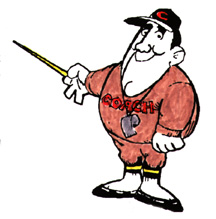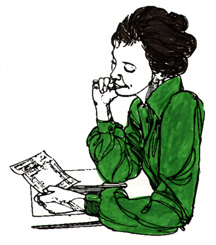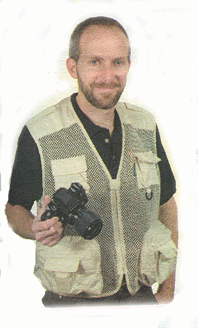|
Guidelines To Wet-Mounting Display Projects Part 1 — Planning Factors |
|
|
As you pursue the development of your display plan, many of the ideas and actions required will be obvious. Others may be more obscure and elusive. Within the scope of the objectives of this presentation, we will strive to cover as many consideration and elements of technique that are necessary to carry through your project. There are basic rules of art, aesthetics and mechanical processes which have evolved into accepted standards, and are proven through time. Combining elements of these types of information with step-by-step procedures, outlined herein, should encourage the completion of your projects, at minimal cost, that might otherwise not have moved beyond the conceptual stage. |
|
|
Graphic Illustration Considerations: With this in mind, consider the following with regard to graphic illustrations: Some of your graphic materials requiring mounting and display, such as maps, posters, drawings, printed certificates, letters, etc., may well include original works. Many will be photographs or photo reproductions. Through the photocopy and reproduction process, you gain control over the size, weight, texture and color of the image, without damage to the original. These instructions are designed to deal only with materials that are amenable to manipulation through use of water-based mediums or that may be camera-copied and be converted to this format. Original drawings, delicate prints, etc., should be mounted and framed for display using other methods.
|
 |
|
One of your challenges will be to identify how and where to obtain usable photo reproductions. If you are a do-it-youselfer, don’t overlook the potential for working out an arrangement with a local high school, vocational school, college graphics department or a local arts/technology center. Your local photographer could possibly help, but probably not by local processing. Most of all photography today is in color, where black and white processing, an often desired medium for display purposes, is more uncommon in most commercial photo stores and processing labs. B&W photography is making somewhat of a resurgence and you may have little difficulty in getting your custom processing accomplished. If you know what to ask for, you will usually be able to work things out. A note of caution: The question of wet-mounting digital images, produced on an ink jet printer, is a very logical consideration in these times. The answer is “NO,” they are not suitable for wet mounting. Laser printed products can be mounted, when great care is used, but ink-jet products deteriorate rapidly as the water-based materials begin to soak into the paper. |
|
| Photo Reproduction: Let us begin by looking at how photo reproduction can work for you. Historic black-and-white photos and more recent color photos may possibly be included in your display plan. The size of available display space, the significance of the image to your story, and the aesthetic relationships in the use of space will all influence the final size you choose for the completed product. In preparing your request for photocopy and printing services, there are additional factors to keep in mind. Photo Size: If you plan to use on-hand photos from your collection, the size of the photos are predetermined. Planning your display size will then be influenced by the sizes of the pictures you have as resources. If you plan to reproduce photos from original negatives and/or camera copy your existing photos, where you create a new negative, your choice of individual picture size and your total display size becomes more of a matter of your own choice. |
 |
| Photo size should be based upon the anticipated use of printing papers to include choices from 5 x 7, 8 x 10, 11 x 14, 16 x 20, and 20 x 24-inch precut sheets. Larger sizes can be special-ordered from some studios. Your selected images can be copied and then printed on any of these paper sizes, and then trimmed to the proportion best suited to the display plan. Whichever paper size is used, you should anticipate some slight loss in trimming. Material charges will normally be based upon the cost of the full sheet, so you should consider selecting your final image size to be slightly smaller than the limits of the paper size required. Don’t feel obligated to use the full height or width, just because it is paid for. There are times when long and thin or tall and slim photos provide a sense of needed variety, and will help hold the attention of the viewer. |
|
|
Types of Photo Paper: Photo processors use a variety of types of photo papers and, if you print your own and select your paper types with care, you will have greater control of your product. It is important that you be aware of the paper types that your commercial processor may use and play a part in the choices made for your processing, if you have that choice. If you are going to do the printing processing, yourself, there are additional reasons for you to be knowledgeable of your options. The following are important factors to consider when selecting paper. |
 |
| 1. Paper Weight: When you have the choice, you will benefit if the display photos you use are printed on heavy-grade paper, usually referred to as double weight or DW. This is especially true for larger collage mural displays. The double weight assures an opaque background where covered-over image parts do not show through the paper on the finished product. 2. Surface Texture: Photo paper manufacturers typically refer to surface finishes as F surface-smooth glossy, N surface-smooth luster, and sometimes, C surface fine-grained luster. Black-and-white, fibre based, display prints perform best for display purposes in an N or C smooth-lustre finish, which assures minimum reflection and glare. Many of the existing B&W and color prints in your files will likely be printed on a glossy or luster type surface. You should realize that, in the end, when wet-mounted and varnished with a matte acrylic varnish, the entire product will have a non-glare, matte surface, finish. 3. Water Permeability: Water-permeable and water-resistant papers each perform in a different manner in the mounting process. Each may be mounted with hot or cold, dry or wet processing, but with varying degrees of heat tolerance, paper expansion, and other factors. The Water-permeable papers provide the widest choices in mounting for the exhibit planner. 4. Paper Choices: References above give you some clues relating to paper choices. If you want a clear and current reference as to what is on the market, I suggest you obtain a catalog of what is on the market. If you have a resource in mind for this purpose, use it. If not, the author of this document suggests you contact Porter’s Camera Store, P.O. Box 628, Cedar Falls, IA 50613-0628. Their free 800 phone number is 1-800-553-2001. I have enjoyed their services for 27 years and they have a periodic newspaper-like catalog of products and services that will go a long way in illustrating options available to you, as it has for me. Other Considerations: Display planners should also consider the following additional factors in developing the special look they wish to achieve: 2. Image Size and Shape: If you are creating a collage display, the selection of the size, shape and facing position of each image can influence elements of emphasis and aesthetics. Strive for a sense of rhythm with variety, thereby enhancing the aesthetic attraction of your display. Make a special review of the sample collages in this presentation to see how image size differential and positioning contribute to the impact and eye-holding qualities of the total composite picture. |
|
|
Go to Wet-Mounting Display Review Pages Go to Wet-Mounting Procedures & Techniques Instruction Go to Wet-Mounting Procedues and Techniques Introduction Go to Education Programs Home Page — Return to RB-29 Home Page |
|